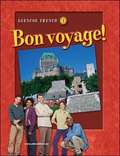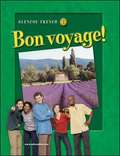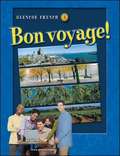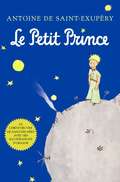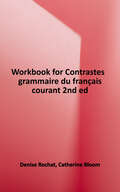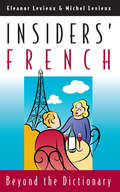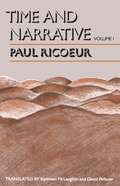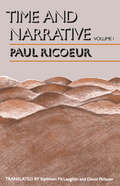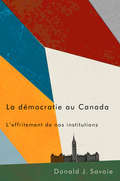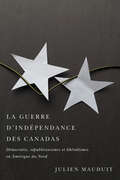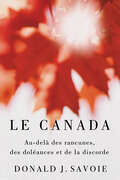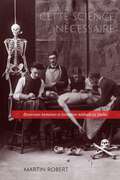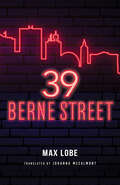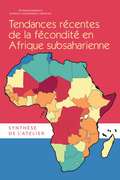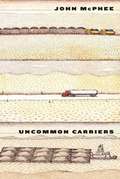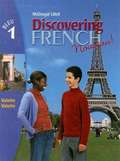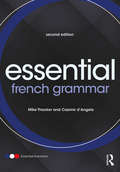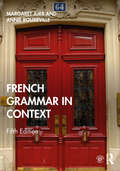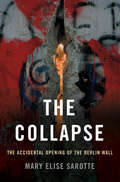- Table View
- List View
Bon Voyage! Glencoe French 3
by Conrad J. Schmitt Katia Brillié LutzWith this text, teachers can select the material they present in depth based on the abilities, needs, and interests of their students. The text is divided into eight chapters that adhere to a very general theme as indicated in the chapter title--Les voyages, La santé, etc. Each chapter contains short lessons on Culture, Conversation, Language, Review Grammar, Journalism, Advanced Grammar, and Literature.
Glencoe French 1: Bon Voyage!
by Conrad J. Schmitt Katia Brillié LutzBon voyage!Clearly the best choice!Bon voyage!(Schmitt and Brillié Lutz) is a comprehensive program that encourages meaningful, practical communication by immersing your students in the language and culture of the Francophone world. The text and its complementary resources help you meet the needs of every student in your diverse classroom.Bon voyage!provides your itinerary for success with exposure to the Francophone culture; clear expectations and goals; thematic, contextualized vocabulary; useful and thematically-linked structure; progressive practice; real-life conversation; cultural readings in the target language; recycling and review; and exquisite National Geographic Society panoramas of the Francophone world.
Bon Voyage! Glencoe French 2
by Conrad J. Schmitt Katia Brillié LutzBon voyage is a comprehensive program that encourages meaningful, practical communication by immersing your students in the language and culture of the Francophone world. The text and its complementary resources help you meet the needs of every student in your diverse classroom.Level 2continues with chapters 13 and 14 from Level 1 as chapters 1 and 2. Révision A-F reviews vocabulary, conversation, and structure. Teachers have the flexibility to review what their students require.Bon voyage!provides your itinerary for success with exposure to the Francophone culture; clear expectations and goals; thematic, contextualized vocabulary; useful and thematically-linked structure; progressive practice; real-life conversation; cultural readings in the target language; recycling and review; and exquisite National Geographic Society panoramas of the Francophone world.
Bon Voyage! Glencoe French 3
by Conrad J. Schmitt Katia Brillié LutzBon voyage!Clearly the best choice!Bon voyage!(Schmitt and Brillié Lutz) is a comprehensive program that encourages meaningful, practical communication by immersing your students in the language and culture of the Francophone world. The text and its complementary resources help you meet the needs of every student in your diverse classroom.Bon voyage!provides your itinerary for successwith exposure to the Francophone culture; clear expectations and goals; thematic, contextualized vocabulary; useful and thematically-linked structure; progressive practice; real-life conversation; cultural readings in the target language; recycling and review; and exquisiteNational Geographic Societypanoramas of the Francophone world.
AP French: Preparing for the Language and Culture Examination
by Richard LaddNIMAC-sourced textbook
Allons au-delà!: La Langue et les Cultures du monde Francophone
by Richard LaddNIMAC-sourced textbook
Le Petit Prince: The Original French Edition
by Antoine de Saint-ExupéryThis timeless classic was embraced by critics and readers across the coun try for its purity and beauty of expression. Saint-Exupry's beloved artwork was restored and remastered to present his work in its original vibrant colors.
Workbook for Contrastes: Grammaire Du Francais Courant
by Denise RochatThe workbook contains exercises that progress from basic to more advanced; from fill in the blank (with answers provided at the end) to sentence completion, from transformation exercises to compositions, culminating in a few English/French translations for the more advanced level.
Insiders' French: Beyond the Dictionary (The\nature Of Human Society Ser.)
by Eleanor Levieux Michel LevieuxIf you had been living in France in the 1990s, the language you would have heard on the radio and television or seen in the newspapers would be far removed from the French language of ten or twenty years ago. The country and its language have changed tremendously in a relatively short period of time, and, as a result, English speakers with a grounding in French can still find themselves struggling to understand terms commonly encountered in contemporary French society. Luckily, Eleanor and Michel Levieux now bring us up to date with their Insiders' French, an utterly entertaining and informative guide to the language of the "new France." This "new France" is a country poised to experience the European single currency but uncertain about being part of Europe. It is hooked on fast food but ambivalent about the country where it originated. France today has record unemployment and an increasingly controversial immigrant population. Clearly, given the rapidly changing conditions and lifestyles, conventional French dictionaries alone cannot completely inform readers and visitors. Insiders' French offers a solution to the incomprehension, a unique handbook in which you'll find the language of European union, the space program, abortion and women's rights, high-tech industries, and health care, among other topics. Entries proceed by association of ideas and related terms, with extensive cross-referencing, while still being alphabetized for easy reference like a standard dictionary. Cartoons from major French journals add to your understanding and enjoyment. Insiders' French opens up the secret territory of French politics and culture that is often not understood by visitors or students, and it does so with wit and verve—qualities that remain in the French language despite its recent changes.
Time and Narrative, Volume 1
by Paul Ricoeur Kathleen Mclaughlin David PellauerTime and Narrative builds on Paul Ricoeur's earlier analysis, in The Rule of Metaphor, of semantic innovation at the level of the sentence. Ricoeur here examines the creation of meaning at the textual level, with narrative rather than metaphor as the ruling concern. Ricoeur finds a "healthy circle" between time and narrative: time is humanized to the extent that it portrays temporal experience. Ricoeur proposes a theoretical model of this circle using Augustine's theory of time and Aristotle's theory of plot and, further, develops an original thesis of the mimetic function of narrative. He concludes with a comprehensive survey and critique of modern discussions of historical knowledge, understanding, and writing from Aron and Mandelbaum in the late 1930s to the work of the Annales school and that of Anglophone philosophers of history of the 1960s and 1970s. "This work, in my view, puts the whole problem of narrative, not to mention philosophy of history, on a new and higher plane of discussion."--Hayden White, History and Theory "Superb. . . . A fine point of entrance into the work of one of the eminent thinkers of the present intellectual age."--Joseph R. Gusfield, Contemporary Sociology
Time and Narrative, Volume 1 (Time and Narrative)
by Paul Ricoeur David Pellauer Kathleen McLaughlinTime and Narrative builds on Paul Ricoeur's earlier analysis, in The Rule of Metaphor, of semantic innovation at the level of the sentence. Ricoeur here examines the creation of meaning at the textual level, with narrative rather than metaphor as the ruling concern. Ricoeur finds a "healthy circle" between time and narrative: time is humanized to the extent that it portrays temporal experience. Ricoeur proposes a theoretical model of this circle using Augustine's theory of time and Aristotle's theory of plot and, further, develops an original thesis of the mimetic function of narrative. He concludes with a comprehensive survey and critique of modern discussions of historical knowledge, understanding, and writing from Aron and Mandelbaum in the late 1930s to the work of the Annales school and that of Anglophone philosophers of history of the 1960s and 1970s. "This work, in my view, puts the whole problem of narrative, not to mention philosophy of history, on a new and higher plane of discussion."—Hayden White, History and Theory "Superb. . . . A fine point of entrance into the work of one of the eminent thinkers of the present intellectual age."—Joseph R. Gusfield, Contemporary Sociology
La démocratie au Canada: L'effritement de nos institutions
by Donald J. SavoieLa démocratie représentative canadienne se heurte à de grandes difficultés. Au sommet de leur liste figure l'incapacité croissante du gouvernement national à remplir ses rôles les plus essentiels, soit planifier des actions collectives qui ont un écho dans toutes les régions, en plus de mettre ces mesures en application. Parmi les autres difficultés, on peut mentionner l'incapacité du Parlement à assumer d'importantes responsabilités, un appareil judiciaire militant, des appels incessants à une plus grande transparence, l'évolution rapide du rôle des médias et une bureaucratie du gouvernement fédéral qui a perdu à la fois son chemin et son influence. Soutenant que les Canadiens doivent réexaminer les origines de leur pays s'ils veulent comprendre pourquoi il est difficile de changer et pourquoi ils continuent à adhérer aux identités régionales, Démocratie au Canada explique en quoi les expériences historiques britanniques ont façonné les institutions nationales canadiennes et pour quelle raison on s'est peu efforcé d'intégrer des réalités canadiennes à l'amalgame. Par conséquent, l'ampleur et la taille du gouvernement et du fédéralisme canadiens ont évolué principalement en dehors de la Constitution. Le Parlement et même le Cabinet désormais ont été mis à l'écart, laissant la voie libre aux responsables des orientations politiques pour concevoir et gérer l'État moderne. Cela explique également la conviction des citoyens ordinaires que les institutions nationales répondent aux besoins des élites économiques, de leurs propres membres et des groupes d'intérêt à leurs propres dépens. Analyse magistrale, La démocratie au Canada examine les forces qui façonnent les rouages du fédéralisme canadien et des institutions politiques et démocratiques nationales du pays.
La démocratie au Canada: L'effritement de nos institutions
by Donald J. SavoieLa démocratie représentative canadienne se heurte à de grandes difficultés. Au sommet de leur liste figure l'incapacité croissante du gouvernement national à remplir ses rôles les plus essentiels, soit planifier des actions collectives qui ont un écho dans toutes les régions, en plus de mettre ces mesures en application. Parmi les autres difficultés, on peut mentionner l'incapacité du Parlement à assumer d'importantes responsabilités, un appareil judiciaire militant, des appels incessants à une plus grande transparence, l'évolution rapide du rôle des médias et une bureaucratie du gouvernement fédéral qui a perdu à la fois son chemin et son influence. Soutenant que les Canadiens doivent réexaminer les origines de leur pays s'ils veulent comprendre pourquoi il est difficile de changer et pourquoi ils continuent à adhérer aux identités régionales, Démocratie au Canada explique en quoi les expériences historiques britanniques ont façonné les institutions nationales canadiennes et pour quelle raison on s'est peu efforcé d'intégrer des réalités canadiennes à l'amalgame. Par conséquent, l'ampleur et la taille du gouvernement et du fédéralisme canadiens ont évolué principalement en dehors de la Constitution. Le Parlement et même le Cabinet désormais ont été mis à l'écart, laissant la voie libre aux responsables des orientations politiques pour concevoir et gérer l'État moderne. Cela explique également la conviction des citoyens ordinaires que les institutions nationales répondent aux besoins des élites économiques, de leurs propres membres et des groupes d'intérêt à leurs propres dépens. Analyse magistrale, La démocratie au Canada examine les forces qui façonnent les rouages du fédéralisme canadien et des institutions politiques et démocratiques nationales du pays.
La guerre d'indépendance des Canadas: Démocratie, républicanismes et libéralismes en Amérique du Nord (Studies on the History of Quebec/Études d'histoire du Québec)
by Julien MauduitLongtemps considérée comme une rébellion mineure, la tentative de révolution de 1837 a en réalité secoué l’ensemble de l’Amérique du Nord, menaçant de renvoyer le pouvoir britannique hors du continent, mais également d’inaugurer une expérience républicaine différente. La révolution a échoué, mais les idées qu’elle a véhiculées - tant progressistes qu’élitistes - résonnent encore aujourd’hui.L’auteur se penche sur les réseaux des patriotes canadiens en exil aux États-Unis en s’appuyant sur des sources canadiennes et étasuniennes. En sollicitant le soutien de leurs « frères » au sud de la frontière, les rebelles ont poussé les autorités des États-Unis à coopérer activement avec l’Empire britannique, dans un dénigrement surprenant de leurs racines révolutionnaires et antibritanniques. Initialement favorables à l’annexion des Canadas aux États-Unis, les patriotes ont dû repenser leur avenir en dehors d’une république qui affichait ses faiblesses. Ils ont envisagé de fonder leur propre république à « deux étoiles », avec l’espoir de régénérer la démocratisation en Amérique et de teinter la transition au capitalisme moderne de morale, de responsabilité sociale et de bienveillance envers les travailleurs manuels. Le livre explore cette guerre singulière en se penchant sur un large éventail d’acteurs, de faits et de questions historiques, comme le nationalisme, les rapports de force politiques ou encore les idéaux des « droits égaux » et du « laissez-nous faire ».En proposant un regard novateur et informé sur un évènement que nous pensions bien connaître, La guerre d’indépendance des Canadas suscitera la discussion pendant de nombreuses années.
Le Canada: Au-delà des rancunes, des doléances et de la discorde
by Donald J. SavoieLa structure politique du Canada va à l’encontre de la géographie économique de l’Amérique du Nord et de l’attraction économique entre le nord et le sud. Le Canada a importé des institutions politico-administratives conçues pour un État unitaire et, depuis la fondation du pays, ses leaders politiques se sont démenés pour qu’elles fonctionnent. Pour cette raison, plusieurs Canadien.ne.s, leurs communautés et leurs régions se perçoivent comme des victimes, et ce, à un degré plus élevé que chez d’autres groupes dans des démocraties occidentales.Notre gouvernement fédéral a démontré un plus grand empressement à s’excuser pour des injustices que les autres pays occidentaux. Le Canada est également plus performant que d’autres nations dans l’aide qu’il apporte aux victimes pour qu’elles fassent la transition les menant à participer pleinement à la vie politique et économique du pays. Donald Savoie soutient que le Canada continue à prospérer malgré les nombreux défauts de ses institutions politiques nationales et le penchant qu’ont les Canadien.ne.s à se voir comme des victimes, et que notre histoire et ces défauts nous ont appris l’art du compromis. La constitution du Canada et ses institutions politiques amplifient plus qu’elles n’atténuent la victimisation ; cependant, elles ont également permis aux Canadien.ne.s de mieux gérer cet enjeu que dans d’autres pays. Les Canadien.ne.s reconnaissent aussi que l’alternative au Canada est pire, et cela, plus que tout autre chose, continue à renforcer l’unité nationale.Puisant dans sa longue expérience dans le monde universitaire et en tant que conseiller auprès des gouvernements, Savoie propose de nouvelles manières de voir comment le Canada travaille pour sa population.
Cette science nécessaire: Dissections humaines et formation médicale au Québec (Studies on the History of Quebec/Études d'histoire du Québec #43)
by Martin RobertPourquoi des étudiants en médecine ont-ils enlevé des cadavres dans les lieux de sépulture durant près de six décennies (c. 1820-1883) au Québec ? Cette science nécessaire fait la lumière sur une histoire originale et méconnue, en nous plongeant dans l’univers macabre des étudiants en médecine du XIXe siècle.On y croise religieuses hospitalières, chiens protégeant les tombes, juges, patients d’institutions psychiatriques, policiers, évêques, ainsi qu’un grand nombre de médecins. Anglophones ou francophones, tous s’animent autour d’une même question : quels morts peut-on disséquer pour apprendre l’anatomie humaine et devenir un médecin compétent ? Écrit dans un style accessible, à partir de sources fascinantes et souvent inédites, Cette science nécessaire montre l’essor de la profession médicale au Québec en expliquant, par exemple, comment une émeute d’étudiants à coups de fémurs transforme la médecine canadienne, comment Trois-Rivières devient une plaque tournante du transport ferroviaire de cadavres, ou encore pourquoi les squelettes fument la pipe sur les images de salles de dissection de l’époque. Le rôle majeur des organisations catholiques et protestantes dans l’enseignement médical au Québec est mis en évidence : Montréal au XIXe siècle devient un environnement médical hybride où coexistent des établissements francophones et anglophones, ayant peu d’équivalents au monde.Cette science nécessaire est une lecture essentielle, tant pour mieux comprendre l’histoire de la formation médicale au Québec et dans le monde, que pour mettre en contexte les débats actuels sur le respect et la dignité dans les pratiques médicales et funéraires.
39 Berne Street (Global African Voices)
by Max Lobe"My mother says that there are things in life that she can't forgive . . ."At age 16, Dipita's mother, Mbila, arrived in Switzerland from Cameroon. Trafficked into Europe, she supported herself and her son as a prostitute in Geneva. Dipita, now a young, black, gay man serving a five-year sentence in a Swiss prison, shares their story and his own search for purpose. He intertwines their stories with the life of Uncle Démoney, a former civil servant in Cameroon, who staked everything on sending his sister to Switzerland.39 Berne Street explores the complex themes of prostitution, immigration, and homosexuality through a fluid and expressive prose that makes it ring true. Originally published in French, it won the Prix du Roman des Romands in 2014.Max Lobe's 39 Berne Street vividly describes the unforgivable actions visited by family members upon family members in desperate bids for survival and contentment in the midst of Dipita's struggle toward forgiveness and acceptance.
Radioactive Sources: Applications and Alternative Technologies: French Version
by National Academies of Sciences, Engineering, and Medicine Division on Earth and Life Studies Nuclear and Radiation Studies Board Committee on Radioactive Sources: Applications and Alternative TechnologiesRadioactive Sources: Applications and Alternative Technologies assesses the status of medical, research, sterilization, and other commercial applications of radioactive sources and alternative (nonradioisotopic) technologies in the United States and internationally. Focusing on Category 1, 2, and 3 sources, this report reviews the current state of these sources by application and reviews the current state of existing technologies on the market or under development that are or could be used to replace radioisotopic technologies in those applications. Radioactive Sources will support existing and future activities under the National Nuclear Security Administration Office of Radiological Security program to reduce the use of high-risk radiological materials in commercial applications.
Tendances Récentes de la Fécondité en Afrique Subsaharienne: Synthèse de l'Atelier
by National Academies of Sciences Engineering MedicineNote: This is the French translation of Recent Fertility Trends in Sub-Saharan Africa. Fertility rates and population growth influence economic development. The marked declines in fertility seen in some developing nations have been accompanied by slowing population growth, which in turn provided a window of opportunity for rapid economic growth. For many sub-Saharan African nations, this window has not yet opened because fertility rates have not declined as rapidly there as elsewhere. Fertility rates in many sub-Saharan African countries are high: the total rate for the region is estimated to be 5.1 births per woman, and rates that had begun to decline in many countries in the region have stalled. High rates of fertility in these countries are likely to contribute to continued rapid population growth: the United Nations projects that the region’s population will increase by 1.2 billion by 2050, the highest growth among the regions for which there are projections. In June 2015, the Committee on Population organized a workshop to explore fertility trends and the factors that have influenced them. The workshop committee was asked to explore history and trends related to fertility, proximate determinants and other influences, the status and impact of family planning programs, and prospects for further reducing fertility rates. This study will help donors, researchers, and policy makers better understand the factors that may explain the slow pace of fertility decline in this region, and develop methods to improve family planning in sub-Saharan Africa.
Multilingual Summary for Evaluation of PEPFAR’s Contribution (2012-2017) to Rwanda’s Human Resources for Health Program
by National Academies of Sciences, Engineering, and Medicine Health and Medicine Division Board on Global Health Committee on the Evaluation of Strengthening Human Resources for Health Capacity in the Republic of Rwanda Under the President's Emergency Plan for AIDS ReliefThis multilingual publication summarizes the recent Evaluation of PEPFAR's Contribution (2012-2017) to Rwanda's Human Resources for Health Program. This study describes PEPFAR investments in HRH in Rwanda over time, including its support for Ministry of Health efforts to address HRH needs and the broader context in which these investments were made; describes PEPFAR-supported HRH activities in Rwanda in relation to programmatic priorities, outputs, and outcomes; examines the impact of PEPFAR funding for the HRH Program on HRH outcomes and on patient- or population-level HIV-related outcomes; and provides recommendations to inform future HRH investments that would support people living with HIV and advance PEPFAR's mission. The summary distills the main messages of the consensus report.
Uncommon Carriers
by John McpheeWhat John McPhee's books all have in common is that they are about real people in real places. Here, at his adventurous best, he is out and about with people who work in freight transportation. Over the past eight years, John McPhee has spent considerable time in the company of people who work in freight transportation. Uncommon Carriers is his sketchbook of them and of his journeys with them. He rides from Atlanta to Tacoma alongside Don Ainsworth, owner and operator of a sixty-five-foot, eighteen-wheel chemical tanker carrying hazmats. McPhee attends ship-handling school on a pond in the foothills of the French Alps, where, for a tuition of $15,000 a week, skippers of the largest ocean ships refine their capabilities in twenty-foot scale models. He goes up the "tight-assed" Illinois River on a "towboat" pushing a triple string of barges, the overall vessel being "a good deal longer than the Titanic." And he travels by canoe up the canal-and-lock commercial waterways traveled by Henry David Thoreau and his brother, John, in a homemade skiff in 1839. Uncommon Carriers is classic work by McPhee, in prose distinguished, as always, by its author's warm humor, keen insight, and rich sense of human character.
Essential French Grammar (Essential Language Grammars)
by Mike Thacker Casimir d'AngeloEssential French Grammar is a student-friendly French grammar designed to give learners a firm foundation on which to build a real understanding of both spoken and written French. Clear explanations of grammar are supported by contemporary examples, lively cartoon drawings and a variety of exercises. Key features of the second edition include: each grammar point explained initially with reference to English parallels between English and French provided where relevant 'Key points' box and tables that summarize grammar concepts real-life language examples in French, with English translations a variety of exercises to reinforce learning a contemporary primary source or literary extract to illustrate grammar in context more detailed coverage of punctuation, accents, spelling and the specific sounds of French This second edition includes an introductory chapter that describes the lexical and grammatical differences between French and English. A glossary of grammatical terms in French and English, useful verb tables, and a key to the exercises are also provided, making this an ideal resource for both independent and class-based learners. Essential French Grammar is an innovative reference grammar and workbook for intermediate and advanced undergraduate students of French. This text is ideal for students at CEFR levels B1 to C1, or Intermediate High to Advanced on the ACTFL scale.
French Grammar in Context: Analysis And Practice (Languages in Context)
by Margaret Jubb Annie RouxevilleNow in its fifth edition, French Grammar in Context presents a unique and exciting approach to learning grammar. Authentic texts from a rich variety of sources, literary and journalistic, are used as the starting point for the illustration and explanation of key areas of French grammar. Each point is consolidated with a wide range of written and spoken exercises. Grammar is presented not as an end in itself, but as a tool essential to enjoying French, understanding native speakers and communicating effectively with them. Literary texts and poems are taken from renowned French authors such as Albert Camus, Zola, André Malraux, Alain Robbe-Grillet, Stendhal and Jacques Prévert. News sources include Libération, Le Point, Marianne, and Le Monde Diplomatique, in addition to articles from regional papers such as Ouest-France and La Voix du Nord. Lifestyle articles are included from magazines such as Elle. This fifth edition has been updated to include new texts for Chapters 24 and 25 and two new revision texts. In addition, this new edition is supported by a revised and extended companion website that offers a wealth of additional interactive exercises to practise and reinforce the material covered. French Grammar in Context is aimed at intermediate and advanced students and is ideal for both independent and class-based study.
The Collapse: The Accidental Opening of the Berlin Wall
by Mary Elise SarotteThe Berlin Wall was erected in 1961 to end all traffic between the city’s two halves: the democratic west and the communist east. The iconic symbol of a divided Europe, the Wall became a focus of western political pressure on East Germany; as Ronald Reagan’s famously said in a 1987 speech in Berlin, "Mr. Gorbachev, tear down this wall!” But as award-winning historian Mary Sarotte shows in [Title TK] , the opening of the Wall on November 9, 1989 was not, as is commonly believed, the East German government’s deliberate concession to outside influence. It was an accident. A carelessly worded memo written by mid-level bureaucrats, a bumbling press conference given by an inept member of the East German Politburo, the negligence of government leaders, the bravery of ordinary people in East and West Berlin--these combined to bring about the end of nearly forty years of oppression, fear, and enmity in divided Berlin. When the news broke, Washington and Moscow could only stand by and watch as Tom Brokaw and other journalists narrated the televised broadcast of this critical moment in the thawing of the cold war. Sarotte opens her story in the months leading up to that fateful day. Following East German dissidents, she shows how their efforts coalesced around opposition to the regime’s restrictions on foreign travel. The city of Leipzig, close to the border with Czechoslovakia, became a hothouse of activism, and protests there quickly grew into massive demonstrations. The East German Politburo hoped to limit its citizens’ knowledge of these marches, but two daring dissidents, East Berliners Aram Radomski and Siegbert Schefke, managed to evade the Stasi and film the largest of them from a church tower. They then smuggled their tape to West Germany; broadcast in both nations, the footage galvanized activists across East Germany, and precipitated the stunning developments on November 9. Facing mounting pressure from its own citizens, the East German Politburo planned to put off enacting any meaningful change to its travel policy by issuing a deceptive ruling that would appear to offer more freedom, but which in fact would allow the state to maintain strict control over its citizen’s movements. But the bureaucrats tasked with preparing the "new” regulations misunderstood their task, and instead drafted a declaration that said East Germans could freely leave the country. This declaration ended up in the hands of regime spokesman Günter Schabowski, who announced the rules at a press conference without understanding their import. Stunned reporters were soon broadcasting the news around the world. Crowds of East Germans began streaming to the Wall, prompting a showdown with border guards, who received no support or direction from East German leadership as the throngs multiplied. By 11:30, Harald Jäger, a second-tier passport control officer, had had enough and finally opened the wall to the mob gathering outside his gate. Even though East German forces successfully regained control by the morning, it was too late--for the wall, for the regime, and for Communism in Eastern Europe. Drawing on evidence from archives in multiple countries and languages, along with dozens of interviews with key actors, including Harald Jäger, [Title TK] is the definitive account of the event that brought down the East German Politburo and came to represent the final collapse of the Cold War order.

